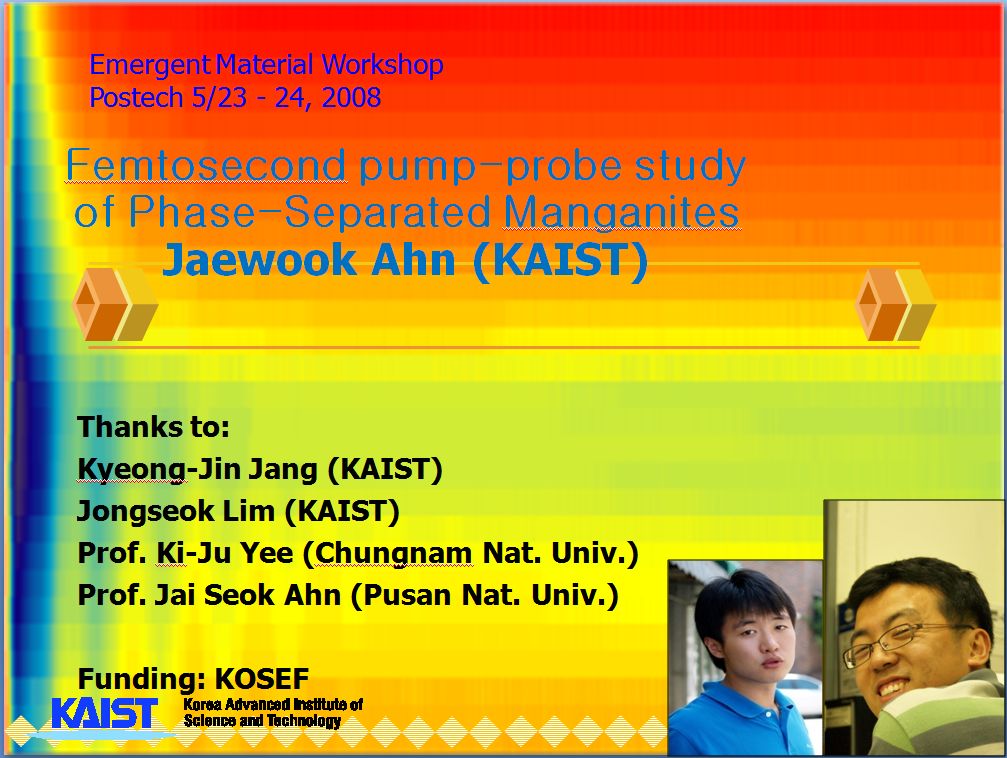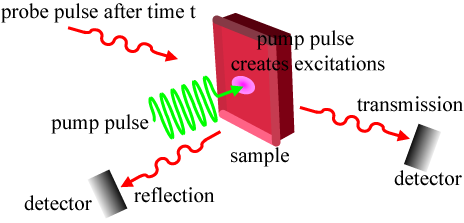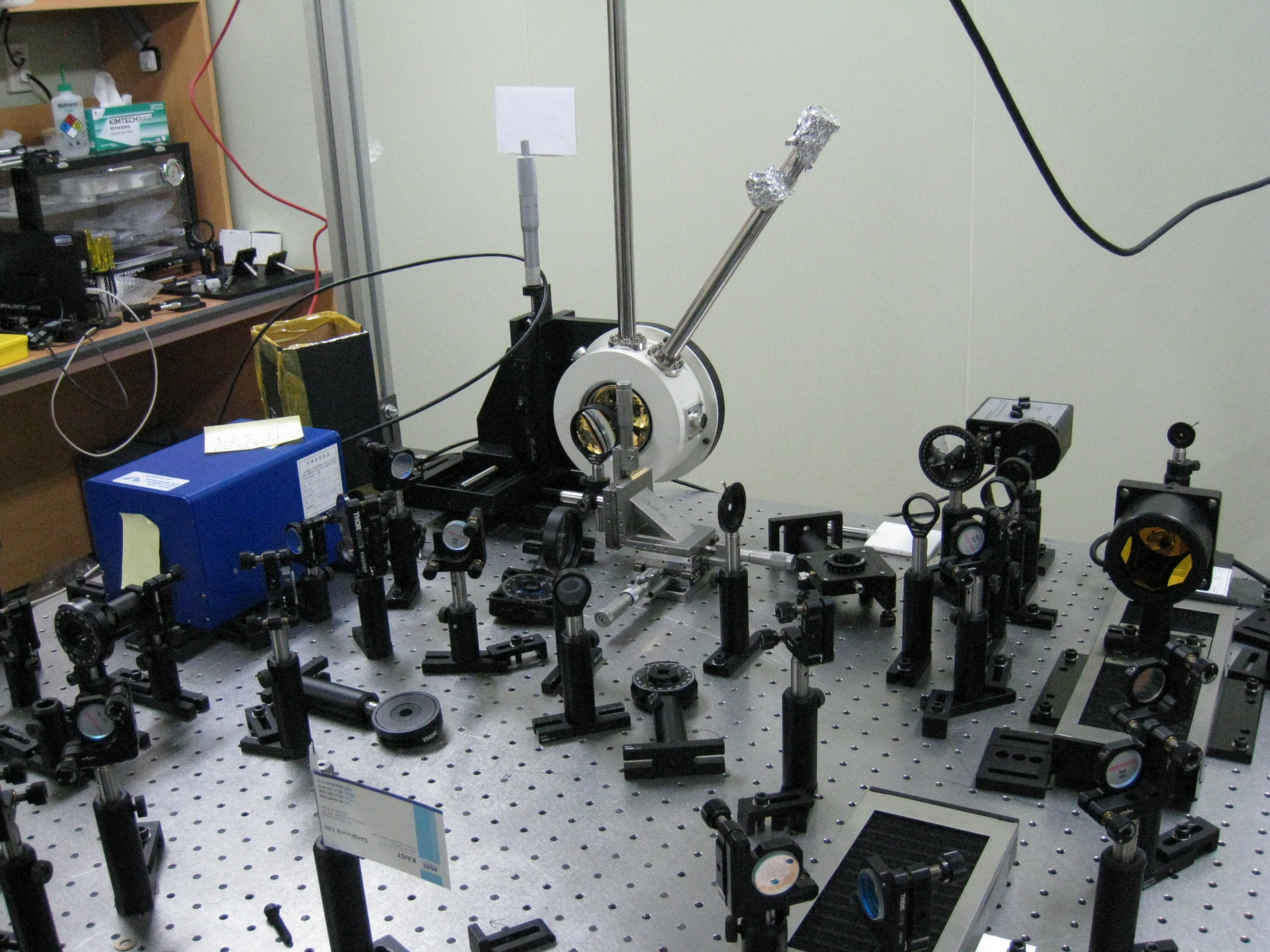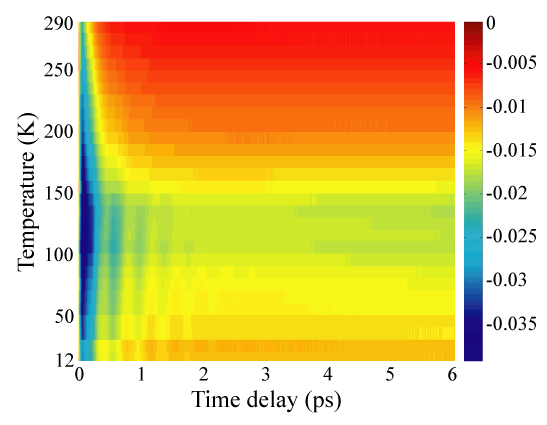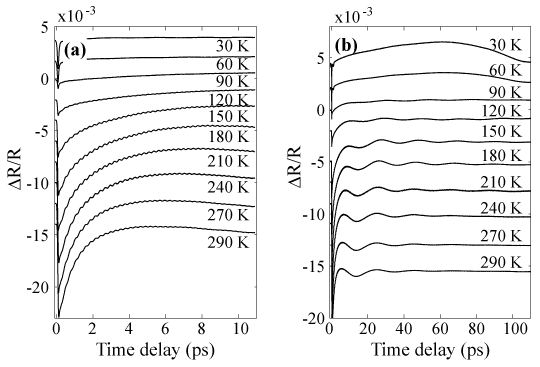Difference between revisions of "Ultrafast Phenomena"
| Line 8: | Line 8: | ||
[[Image:Pump-probe setup.JPG|right|250px]] | [[Image:Pump-probe setup.JPG|right|250px]] | ||
Our research of ultrafast phenomena is investigations non-equilibrium states of electron, phonon, and spins in correlated electron materials, especillay we are interested in rare-earth manganites. We have executed in phase-sepearted manganite, <math>\rm{La_{1/4}Pr_{3/8}Ca_{3/8}MnO_3</math>, and multiferroic hexagonal manganites <math>\rm{LuMnO_3}</math>. | Our research of ultrafast phenomena is investigations non-equilibrium states of electron, phonon, and spins in correlated electron materials, especillay we are interested in rare-earth manganites. We have executed in phase-sepearted manganite, <math>\rm{La_{1/4}Pr_{3/8}Ca_{3/8}MnO_3</math>, and multiferroic hexagonal manganites <math>\rm{LuMnO_3}</math>. | ||
| − | <br>The setup of pump-probe system is shown in right figure. The temperature of the sample was varied from 5 to 300 K in a JANIS ST-500 cryostat filled with liquid He. | + | <br>The setup of pump-probe system is shown in right figure. The temperature of the sample was varied from 5 to 300 K in a JANIS ST-500 cryostat filled with liquid He. <br><br> |
[[Image:LPCMO_result.png|left|250px]] | [[Image:LPCMO_result.png|left|250px]] | ||
#'''Phase-seperated manganite''' <br> | #'''Phase-seperated manganite''' <br> | ||
| − | First of all, under 1 ps time delay, the electronic relaxation is occured. In a few ps time scale (1~6 ps), the coherent optical phonons are generated and decreased(dephasing). And in a longer time delay, the coherent acoustic phonon are generated. The temperature dependence of electronic relaxation is relatively simple, however, those of phonons are related to phase of <math>\rm{La_{1/4}Pr_{3/8}Ca_{3/8}MnO_3</math>. These coherent phonons enables a study of mode-selective relaxation dynamics between excited energy carriers. | + | First of all, under 1 ps time delay, the electronic relaxation is occured. In a few ps time scale (1~6 ps), the coherent optical phonons are generated and decreased(dephasing). And in a longer time delay, the coherent acoustic phonon are generated. The temperature dependence of electronic relaxation is relatively simple, however, those of phonons are related to phase of <math>\rm{La_{1/4}Pr_{3/8}Ca_{3/8}MnO_3</math>. These coherent phonons enables a study of mode-selective relaxation dynamics between excited energy carriers.<br><br> |
[[Image:Raw LuMnO.png|left|250px]] | [[Image:Raw LuMnO.png|left|250px]] | ||
#'''Multiferroic hexagonal manganite'''<br> | #'''Multiferroic hexagonal manganite'''<br> | ||
There are the coherent optical and acoustic phonons above Neel temperature (<math>T_{\rm N}</math>). These phonons are not generated in antiferromagnetic phase. This behavior is consistent with the dynamic spin-phonon couping and the giant magnteo-elastic coupling pictures in the hexagonal manganites. | There are the coherent optical and acoustic phonons above Neel temperature (<math>T_{\rm N}</math>). These phonons are not generated in antiferromagnetic phase. This behavior is consistent with the dynamic spin-phonon couping and the giant magnteo-elastic coupling pictures in the hexagonal manganites. | ||
Revision as of 04:32, 7 October 2009
Time-resloved pump-probe experiment is a useful tool in studying the dynamics related to electrons, phonons, and spin.
The basic analogy of IR pump-probe method is simple that a powerful light pulse, usulally labeled the 'pump pulse' of 'excitation pulse', interacts with the sample and excites it into a non-equilibrium state. The sample thereafter relaxes towards a new equilibrium state. This process can be mapped by sending a second much weaker pulse, 'probe pulse', onto a sample. The 'probe pulse' detects a change of optical properties without disturbing the object under investigation.
Left figure shows simple scheme of this technique.
Our research of ultrafast phenomena is investigations non-equilibrium states of electron, phonon, and spins in correlated electron materials, especillay we are interested in rare-earth manganites. We have executed in phase-sepearted manganite, <math>\rm{La_{1/4}Pr_{3/8}Ca_{3/8}MnO_3</math>, and multiferroic hexagonal manganites <math>\rm{LuMnO_3}</math>.
The setup of pump-probe system is shown in right figure. The temperature of the sample was varied from 5 to 300 K in a JANIS ST-500 cryostat filled with liquid He.
- Phase-seperated manganite
First of all, under 1 ps time delay, the electronic relaxation is occured. In a few ps time scale (1~6 ps), the coherent optical phonons are generated and decreased(dephasing). And in a longer time delay, the coherent acoustic phonon are generated. The temperature dependence of electronic relaxation is relatively simple, however, those of phonons are related to phase of <math>\rm{La_{1/4}Pr_{3/8}Ca_{3/8}MnO_3</math>. These coherent phonons enables a study of mode-selective relaxation dynamics between excited energy carriers.
- Multiferroic hexagonal manganite
There are the coherent optical and acoustic phonons above Neel temperature (<math>T_{\rm N}</math>). These phonons are not generated in antiferromagnetic phase. This behavior is consistent with the dynamic spin-phonon couping and the giant magnteo-elastic coupling pictures in the hexagonal manganites.
